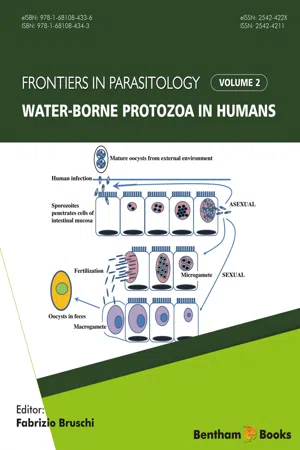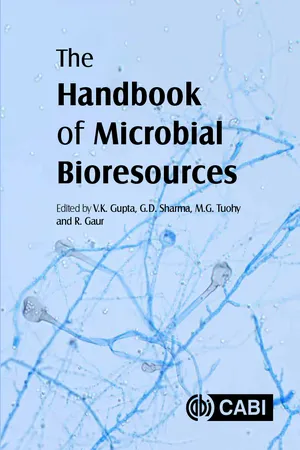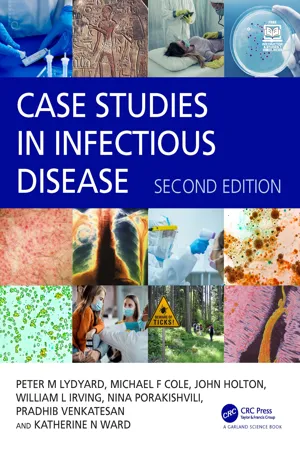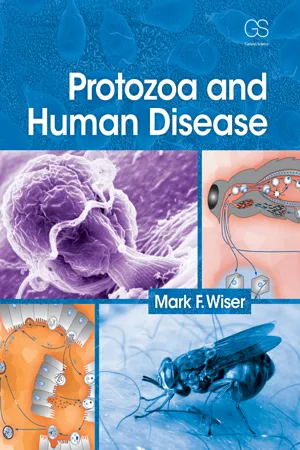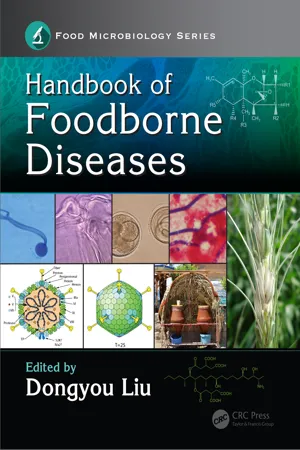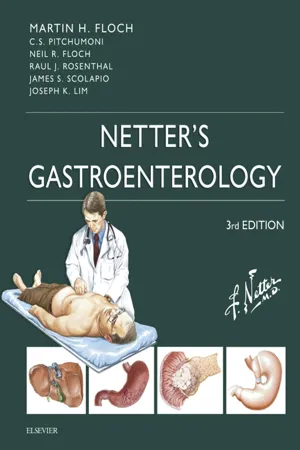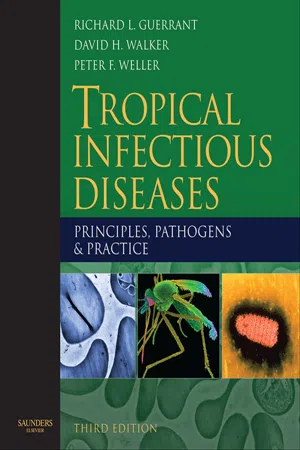Biological Sciences
Giardiasis
Giardiasis is a parasitic infection caused by the protozoan Giardia intestinalis. It commonly spreads through contaminated water and food, leading to symptoms such as diarrhea, abdominal cramps, and nausea. The infection can be treated with antibiotics, and preventive measures include practicing good hygiene and consuming safe drinking water.
Written by Perlego with AI-assistance
Related key terms
Related key terms
1 of 4
Related key terms
1 of 3
12 Key excerpts on "Giardiasis"
- eBook - ePub
- Jiri Mestecky, Michael E. Lamm, Pearay L. Ogra, Warren Strober, John Bienenstock, Jerry R. McGhee, Lloyd Mayer(Authors)
- 2005(Publication Date)
- Academic Press(Publisher)
Giardia cysts present in contaminated water or food. In the proximal small intestine, the cysts release freely mobile trophozoites, which burrow into the mucus layer and attach to the surface epithelium. The trophozoites remain in the proximal small bowel, where they reproduce by binary fission. Some of the trophozoites encyst and leave the host in the stool, allowing continuation of the life cycle. The cysts survive well in the external environment, particularly when exposed to cool and moist conditions. Some wild and domestic animals can act as reservoirs of human infection. Cysts can contaminate natural and domestic freshwater supplies and are relatively resistant to chlorination. Swimming pools can also be a source of infection. The disease occurs worldwide, in both temperate and tropical climates. Regional prevalence rates vary from 2% to 30%, with industrialized societies having the lowest frequency. Some groups are at higher risk of infection; these include infants and young children, campers, travelers to regions with high prevalence, immunodeficient individuals, and people with poor hygiene or who are institutionalized.Giardiasis can present in several different ways. Most people acutely infected with Giardia have few or no symptoms but may develop a carrier state. Others have acute but self-limiting, nonbloody diarrhea lasting from 2 to 6 weeks. Still others develop chronic diarrhea with malabsorption and weight loss. Children may suffer impairment of growth and development. Parasite strain variations or undefined host factors may play an important role in determining the clinical presentation. The diagnosis can be made by microscopic identification of cysts or trophozoites in the stool, duodenal biopsy specimens, or duodenal aspirates or with an immunological test that detects specific Giardia antigens in feces. Several medications are effective against G. intestinalis , but there are treatment failures.Host immunity
Giardia trophozoites reside in the proximal small intestine close to the apical surface of the epithelium and do not invade. Microscopic examination of duodenal or jejunal biopsies may reveal partial villous atrophy with a mild lymphocytic infiltrate or no abnormalities. It is unknown exactly how this parasite induces epithelial injury and diarrhea. Symptoms may result from release of parasite-derived cytopathic factors, direct contact injury, stimulation of the host’s own immunological mechanisms, deconjugation of bile salts, or inhibition of luminal enzyme activity.The immunological mechanisms required for parasite clearance or protective immunity have not been determined. Some immunodeficiency states predispose to chronic Giardiasis and its associated diarrhea. This condition is reported most frequently in patients having common variable immunodeficiency syndrome with hypogammaglobulinemia. Yet, Giardiasis is not a major clinical problem for patients with acquired immunodeficiency syndrome (AIDS). Giardia induced some degree of proliferation and IFN-γ production by CD4+ T lymphocytes in intestine and blood but did not trigger cytotoxicity or migration (Ebert, 1999 ). A T-cell– dependent mechanism is essential for controlling acute giardia infection, which is independent of antibody or B cells (Singer and Nash, 2000 - eBook - ePub
- Fabrizio Bruschi(Author)
- 2017(Publication Date)
- Bentham Science Publishers(Publisher)
Giardia and GiardiasisINTRODUCTION
Giardia intestinalis, also known as Giardia duodenalis or Giardia lamblia, is aunicellular protozoan parasite that infects the upper intestinal tract of humans and animals [1 ]. The disease, Giardiasis, manifests in humans as a bout of acute diarrhea that can develop to a chronic stage but the majority of infections remain asymptomatic [2 , 3 ]. Giardiasis has a global distribution with 280 million cases reported annually, with its impact being more pronounced in the developing world, where it is usually associated with poor socioeconomic conditions [4 ]. Children, elderly people and immunocompromised individuals are the most affected by the disease [5 - 7 ]. In children specifically, effects on growth, nutrition and cognitive function have been reported [8 - 10 ]. Currently, it has been suggested that Giardiasis could predispose for chronic gastrointestinal disorders such as irritable bowel syndrome (IBS) [11 , 12 ]. In 2004, Giardiasis was recognized by the World Health Organization (WHO) as a neglected disease associated with poverty, impairing development and socio-economic improvements [13 ]. Because Giardiasis adds to the global microbial disease burden, an initiative was instigated to implement a comprehensive approach for control and prevention [13 ]. One area of focus is the potential spread of Giardiasis via food and food handling [14 , 15 ], daycare settings [16 , 17 ], travel to endemic areas and close human contact [18 - 20 ]. Potential transmission of Giardiasis from animals to humans (i.e. zoonosis) has been also the subject of extensive research over the years. Wildlife accessibility to water used for drinking and recreational purposes, as well as living in proximity with animals, have been identified as risk factors associated with zoonosis [21 - 23 ]. Another body of research addressed the effect of Giardiasis on livestock. Not only transmission in livestock but also economic losses associated with poor growth, weight loss, reduced productivity and even death of animals [24 - 28 - eBook - ePub
- Vijai Kumar Gupta, Gauri Dutt Sharma, Maria G Tuohy, Rajeeva Gaur, Vijai Kumar Gupta, Gauri Dutt Sharma, Maria G Tuohy, Rajeeva Gaur(Authors)
- 2016(Publication Date)
- CAB International(Publisher)
14 Giardia and Giardiasis: an Overview of Recent DevelopmentsSandipan GangulyNational Institute of Cholera and Enteric Diseases, Kolkata, India*and Dibyendu RajAbstractGiardia lamblia is one of the most common protozoan enteric pathogens that inhabits the upper small intestine of humans and several other vertebrates and causes Giardiasis. Global prevalence of Giardiasis has been estimated to be 300 million cases annually. To adapt in environments both inside and outside the small intestine of the host, this protozoan parasite undergoes significant developmental changes during its life cycle. It has been confirmed that G. lamblia has become drug resistant and biochemical studies have been undertaken to investigate the cause of resistance. This chapter focuses on the most current findings regarding the important advances in understanding the molecular mechanisms that regulate the antigen switching process, including oxidative stress and expressional modifications in Giardia, and potential drug targets for the treatment of Giardiasis are discussed.14.1 Introduction
The micro-aerotolerant Giardia lamblia, a unicellular, gastrointestinal flagellated protozoan causes one of the most frequent parasitic infections worldwide (Adam, 1991 ). It lacks conventional mitochondria, Golgi body and peroxisomes. In 2002 an estimated 280 million symptomatic human infections were reported every year (Lane and Lloyd, 2002 ) but more recently this has risen to 300 million cases annually (Morrison et al., 2007 ). The symptoms of Giardiasis are watery diarrhoea, abdominal pain, irritable bowel syndrome, nausea, vomiting, weight loss and the symptoms appear 6–15 days after infection (Farthing, 1997 ). The disease symptoms have been observed to be more profound in malnourished children and in immunodeficient individuals. Metronidazole or other nitroimidazoles are the common treatment options. Giardia species cannot invade the gut and it secretes no well-known toxin but recent data suggests that Giardia increases intestinal permeability by augmenting apoptosis of the inner cell lining of the intestine (Singer and Nash, 2000 ; Scott et al., 2002 ). Due to its potential as a zoonotic pathogen, farm animals get infected hampering the economic yield (O’Handley et al., 2001 ). Even though this infection is chronic nearly half of cases are asymptomatic and infection subsides without drug treatment (Farthing, 1997 ). It has been put forward that certain gastrointestinal disorders like irritable bowel syndrome can be related to a previous Giardia infection (Hanevik et al., 2009 - eBook - ePub
- Peter Lydyard, Michael Cole, John Holton, Will Irving, Nino Porakishvili, Pradhib Venkatesan, Kate Ward(Authors)
- 2023(Publication Date)
- CRC Press(Publisher)
WHAT IS THE CAUSATIVE AGENT, HOW DOES IT ENTER THE BODY, AND HOW DOES IT SPREAD A) WITHIN THE BODY AND B) FROM PERSON TO PERSON? ■ Giardia is a protozoan flagellate. It has two stages – a trophozoite and a cyst with a highly resistant wall. ■ Giardia consists of six species. Only one species infects humans and this is variously referred to as G. intestinalis, lamblia or duodenalis. There are at least eight genotypes or assemblages (A-H). Only A and B are human pathogens, with B being the most frequent globally. Other genotypes are seen in other mammals and birds. ■ The main infectious stage is the cyst; cysts are ingested in contaminated water or food. They lose their cell wall in the duodenum and emerge as trophozoites, which attach to the intestinal wall through their ventral “sucking” disk and feed. They colonize large areas of epithelial surface. They rarely invade the epithelium and spread systemically. They become encysted again and both trophozoites and cysts pass out of the body in stools. ■ Contamination of public drinking supplies has led to Giardiasis epidemics. When children become infected, up to 25% of their family members also become infected. Individuals can shed cysts in their feces and remain symptom-free. Sexual transmission of Giardia has been described in homosexual males. ■ Giardia is found in a wide variety of different animal species and has been regarded as a zoonosis, although there is little evidence for animals being a significant source of human Giardiasis. ■ Giardiasis is one of the most common causes of diarrhea worldwide. There are around 280 million cases a year. It is more commonly found in children where, in developing countries, it is estimated that up to 20% are infected. ■ Giardia is widespread in the US, with a prevalence of an estimated 1.2 million with the majority not identified due to the carrier being asymptomatic. Infection is most common in late summer and early fall due to outdoor water activities - eBook - ePub
- Mark F Wiser(Author)
- 2010(Publication Date)
- Garland Science(Publisher)
Giardia is a protozoan parasite that colonizes the upper portions of the small intestine. Giardia virtually never penetrates the intestinal epithelium and often results in asymptomatic infections. Symptomatic Giardiasis is characterized by acute or chronic diarrhea and/or other gastrointestinal manifestations. The worldwide prevalence of symptomatic Giardiasis is believed to be more than 200 million cases with 500 000 new cases reported per year.Life Cycle and Morphology
Giardia exhibits a typical fecal–oral life cycle consisting of infectious cyst stages passed in the feces and replicating trophozoites found in the small intestine (Figure 4.1 ). The infection is acquired through the ingestion of food or water contaminated with cysts. Factors leading to contamination of food or water with fecal material are correlated with transmission (Chapter 2 ). For example, in the United States Giardiasis is especially prevalent in children and particularly those children in institutions or day-care centers. In developing countries, poor sanitation contributes to the higher levels of Giardiasis and waterborne outbreaks due to inadequate water treatment have also been documented.Figure 4.1 Life cycle and morphology of Giardia.(A) Schematic drawing showing typical fecal–oral life cycle of Giardia and major morphological features of trophozoites and cysts. (B) Micrograph of stained cyst from feces. (C) Micrograph of stained trophozoite from feces.(Figures B and C from the Parasite Image Library, CDC’s Division of Parasitic Diseases (DPD) with permission from the Center for Disease Control (CDC).)Zoonotic transmission potential
Giardia duodenalis infects a wide range of mammals and it has long been considered that Giardia infections could be potentially acquired from animals (i.e., zoonotic transmission). For example, in parts of Canada and the northern United States Giardiasis has been referred to as “beaver fever” following an outbreak at Banff National Park in Canada that was associated with lakes and streams inhabited by beavers. It has also been called “hiker’s diarrhea” in reference to the belief that hikers and campers often acquire Giardia infections by drinking from streams contaminated with animal feces. However, the zoonotic transmission of Giardia - eBook - ePub
- Jane E. Sykes(Author)
- 2013(Publication Date)
- Saunders(Publisher)
Giardia infection involves boiling or filtering of water collected from the environment before drinking and disinfection of premises contaminated with infected feces with steam cleaning or quaternary ammonium compounds (1 minute contact time). Transport hosts should be controlled, and treatment and bathing of all animals in the environment could be considered if intermittent diarrhea occurs. Feces from infected animals should be removed from the environment promptly.Public Health Aspects
In humans, infection with Giardia can be asymptomatic or result in acute or chronic gastrointestinal illness. Acute Giardiasis is characterized by watery diarrhea, epigastric pain, nausea, vomiting, decreased appetite, and weight loss; these signs occur 6 to 15 days after infection. Young children and immunodeficient individuals are most likely to show clinical signs; chronic infections are also more likely to occur in the immunocompromised. Recent studies suggest that functional gastrointestinal disorders such as irritable bowel syndrome can be associated with a previous Giardia duodenalis infection.41Infection with the Giardia assemblages of dogs (assemblage C and D) or cats (assemblage F) is usually not associated with clinical disease in humans, but can be detected in the feces of immunocompromised people.1 Human assemblages A and B can be found in feces of dogs and cats when animals share human environmental features (i.e., contaminated water). However, it is unlikely that new human infections by Giardia assemblages A or B are acquired from dogs or cats.3 Thus, healthy animals that test positive for Giardia are probably not significant human health risks if the family members are also healthy. Greater risk is likely to exist for immunocompromised people, and so the potential for contact with infected feces should be minimized.CASE EXAMPLESignalment “Duke,” a 12-week-old intact male Golden retriever from Fort Collins, COHistoryDuke was adopted from a backyard breeder. The puppy was eating well and was in good body condition. Small bowel diarrhea was the only historical complaint. The stool character varied from soft to watery with occasional streaks of white material that was interpreted as mucus. The diarrhea began just after adoption (a week before evaluation). This was also the time that a new commercial puppy food designed for large-breed dogs was introduced by the owner. The puppy’s first two vaccines (attenuated live distemper, adenovirus, parvovirus, parainfluenza virus) had been administered at 7 and 10 weeks of age, at which times he also was administered pyrantel pamoate orally for strategic deworming. It was unknown whether or not other littermates had diarrhea or parasitic infections. The resident adult collie was considered normal by the owner, and the adult dog’s feces were normal the previous day. - eBook - ePub
- Dongyou Liu, Dongyou Liu(Authors)
- 2018(Publication Date)
- CRC Press(Publisher)
57 Giardia R. Calero-Bernal and D. CarmenaContents 57.1Introduction 57.2Taxonomy 57.3Structure 57.4Life Cycle 57.5Epidemiology 57.6Clinical Disease and Pathogenesis 57.7Laboratory Diagnosis 57.8Treatment 57.9Prevention 57.10Future Perspectives References57.1IntroductionMembers of the genus Giardia are ubiquitous flagellated protozoa that infect the intestinal tracts of a wide range of vertebrates including mammals, amphibians, and birds. Among them, G. duodenalis is the etiological agent of Giardiasis, a major cause of gastrointestinal illness estimated to affect about 200 million people each year only in developing countries.1 Although not formally considered a neglected tropical disease, Giardiasis belongs to the group of poverty-related infectious diseases that impair the development and socioeconomic potential of infected individuals in endemic areas. G. duodenalis is also a significant contributor to the burden of diarrheal disease in developed countries.2 The infection is transmitted via the fecal-oral route after ingestion of cysts either indirectly through contaminated water, food, or fomites, or directly through contact with infected individuals or animals. Host (age, immune status, concomitant intestinal microbiota, and diet) and parasite (genotype, virulence, resistance to chemotherapy, and ability to evade immune response) determinants will define the outcome of the infection, whose clinical manifestations range from asymptomatic carriage, self-limited acute diarrhea, and chronic infection.3 In recent years, molecular methods including polymerase chain reaction (PCR)–based assays, sequencing, and phylogenetic analyses have made a substantial contribution to our understanding not only of the epidemiology, but also the taxonomy, evolutionary history, diagnostics, and pathogenesis of G. duodenalis - eBook - ePub
Netter's Gastroenterology E-Book
Netter's Gastroenterology E-Book
- Martin H. Floch, C.S. Pitchumoni, Neil R. Floch, Raul Rosenthal, James Scolapio, Joseph K. Lim, C.S. Pitchumoni, Neil R. Floch, Raul Rosenthal, James Scolapio, Joseph K. Lim(Authors)
- 2019(Publication Date)
- Elsevier(Publisher)
Clin Microbiol Rev . 2012;25(3):420–449.Hill DR, Nash TE. Giardia lamblia. Mandell GL, Bennett JE, Dolin R. Mandell, Douglas and Bennett's principles and practice of infectious diseases . ed 8. Elsevier–Churchill Livingstone: Philadelphia; 2015:3154–3160.Minetti C, Chalmers RM, Beeching NJ, et al. Giardiasis. BMJ . 2016;355:i5369.Mohapatra S, Singh DP, Alcid D, Pitchumoni CS. Beyond O&P times three. Am J Gastroenterol . 2018;113:805–818.Soares R, Tasca T. Giardiasis: an update review on sensitivity and specificity of methods for laboratorial diagnosis. J Microbiol Methods . 2016;129:98–102.Passage contains an image
117C.S. PitchumoniIntestinal Helminths
Trichuriasis
Intestinal helminths are common worldwide, but the most important and common soil transmitted helminthic infections are by Ascaris lumbricoides, Trichuris trichiura, and the two hookworm species Ancylostoma duodenale and Necator americanus.Trichuris trichiura is commonly known as the “whipworm” because of its morphology. Its life cycle is simpler than that of the other helminths (Fig. 117.1 ). Trichuris eggs are ingested in contaminated food and water (see Fig. 123.1 ). They mature in the distal small bowel and then pass into the colon. Adult worms migrate to the cecum and the appendix, where they live, copulate, and deposit eggs. The eggs pass through the feces to complete the life cycle.Fig. 117.1 Trichuriasis: Life Cycle of Trichuris Nematode Helminth (Whipworm).Trichuriasis currently affects an estimated 1 billion persons worldwide, with most infections concentrated in the tropics or the semitropics. Trichuris trichiura - eBook - ePub
- Daniel K. Podolsky, Michael Camilleri, J. Gregory Fitz, Anthony N. Kalloo, Fergus Shanahan, Timothy C. Wang, Daniel K. Podolsky, Michael Camilleri, J. Gregory Fitz, Anthony N. Kalloo, Fergus Shanahan, Timothy C. Wang(Authors)
- 2015(Publication Date)
- Wiley-Blackwell(Publisher)
For example, individuals with immunoglobulin deficiencies are at significantly higher risk for chronic Giardia infection [99,100]. Although animal studies suggest that cell-mediated immunity could play a role in host defense against Giardia [101], children with a severe T-cell deficiency due to thymic aplasia (Di George syndrome), or purine nucleoside phosphorylase deficiency are not more susceptible to Giardiasis, and their morbidity is comparable with that in immunocompetent children. The clinical course of Giardiasis does not appear to be altered in patients infected with the human immunodeficiency virus (HIV) [102]. Ingestion of maternal antibody in breast milk appears to provide infants with protection from symptomatic disease but does not stop the establishment of Giardia infection [103]. Clinical Manifestations Studies of human volunteers suggest that the incubation period for symptomatic disease is 1–2 weeks and the infectious dose can be as low as 10 cysts [78,104]. It is important to note that the onset of symptoms may precede the excretion of cysts in stool by more than 1 week [105]. The clinical presentation is varied and can be classified in one of three syndromes: asymptomatic carrier state, acute self-limiting diarrhea, and chronic diarrhea. Asymptomatic infection is probably the most common outcome of Giardia infection [106,107]. In individuals who develop symptoms, the most common presentation is that of diarrhea with watery foul-smelling stools, often with abdominal distention, flatulence, nausea, flatus, anorexia, and vomiting. Blood and mucus in the stool are rare. Low-grade fever also may be observed, and in some individuals, fatigue and malaise or headache may be prominent. Although infection is self-limiting in most healthy individuals, a significant proportion (25%–30%) come to medical attention because of chronic diarrhea, often with features of steatorrhea and weight loss - eBook - ePub
- John A. Walker-Smith(Author)
- 2013(Publication Date)
- Butterworth-Heinemann(Publisher)
Reduction of intraluminal bile salt concentrations may thus be physiologically important and impair fat absorption. In summary the major factors implicated in the production of diarrhoea and malabsorption in Giardiasis appear to be (1) small intestinal mucosal damage and inflammation; (2) bacterial overgrowth with bile salt deconjugation; and possibly (3) bile salt uptake by parasite. Prevalence Giardia lamblia is endemic in most countries of the world, especially in warm climates and countries with poor sanitary practice. Prevalence rates approach 10% in some areas of the USA and Europe (Petersen, 1972) and up to 30% in some areas of the developing world. All members of a cohort of rural Guatemalan children suffered at least one episode of Giardia infestation by the age of 3 years (Farthing et al. (1986a, b). Giardiasis is probably the most common water-borne disease in the USA. Contaminated surface water and inadequate water treatment are probably the most important factors in the spread of disease. Epidemiological studies suggest that the beaver and other wild and domestic animals are possible reservoirs of Giardia lamblia. Person-to-person transmission is important within families in nurseries, day-care centres and other residential institutions. The prevalence of Giardiasis may be very high in children’s institutions; for example 40% in one series reported from Australia (Court and Stanton, 1959). Carswell, Gibson and McAllister (1973) have examined a large group of Glasgow children for Giardia lamblia. They studied, first, a control group of inpatients who had no clinical evidence of either Giardiasis of coeliac disease; secondly, a group of children with coeliac disease; and thirdly a group of children investigated for coeliac disease but in whom this diagnosis was excluded. There was no difference in the frequency of detection of giardia (16-17%) in the stools of these three groups of children - Richard L. Guerrant, David H. Walker, Peter F. Weller(Authors)
- 2011(Publication Date)
- Saunders(Publisher)
Scand J Infect Dis . 1997;32:48.122 Chen XM, Keithly JS, Paya CV, et al. Cryptosporidiosis. N Engl J Med . 2002;346:1723.123 Astiazaran-Garcia H, Espinosa-Cantellano M, Castanon G, et al. Giardia lamblia : effect of infection with symptomatic and asymptomatic isolates on the growth of gerbils (Meriones unguiculatus ). Exp Parasitol . 2000;95:128.124 Paintlia AS, Descoteaux S, Spencer B, et al. Giardia lamblia groups A and B among young adults in India. Clin Infect Dis . 1998;26:190.125 Sahagun J, Clavel A, Goni P, et al. Correlation between the presence of symptoms and the Giardia duodenalis genotype. Eur J Clin Microbiol Infect Dis . 2008;27:81.126 Haque R, Mondal D, Karim A, et al. Prospective case-control study of the association between common enteric protozoal parasites and diarrhea in Bangladesh. Clin Infect Dis . 2009;48:1191.127 Ajjampur SS, Sankaran P, Kannan A, et al. Giardia duodenalis assemblages associated with diarrhea in children in South India identified by PCR-RFLP. Am J Trop Med Hyg . 2009;80:16.128 Homan WL, Mank TG. Human Giardiasis: genotype linked differences in clinical symptomatology. Int J Parasitol . 2001;31:822.129 Gelanew T, Lalle M, Hailu A, et al. Molecular characterization of human isolates of Giardia duodenalis from Ethiopia. Acta Trop . 2007;102:92.130 Cedillo-Rivera R, Darby JM, Enciso-Moreno JA, et al. Genetic homogeneity of axenic isolates of Giardia intestinalis derived from acute and chronically infected individuals in Mexico. Parasitol Res . 2003;90:119.131 Robertson LJ, Forberg T, Hermansen L, et al. Molecular characterisation of Giardia isolates from clinical infections following a waterborne outbreak. J Infect . 2007;55:79.132 Yason JA, Rivera WL. Genotyping of Giardia duodenalis isolates among residents of slum area in Manila, Philippines. Parasitol Res- eBook - ePub
- Peter D. Walzer, Robert M. Genta(Authors)
- 2020(Publication Date)
- CRC Press(Publisher)
:165170 (1980).- 47. Walzer, P. D., Wolfe, M. S., and Schultz, M. G. Giardiasis in travelers. J. Infect. Dis. 124:235-231 (1971).
- 48. Brodsky, R. E., Spencer, H. C., Jr., and Schultz, M. G. Giardiasis in American travelers to the Soviet Union. J. Infect. Dis. 130:319-323 (1974).
- 49. Karapetyan, A. E. A method of cultivation of Giardia. Tsitologiia 2:379384 (1960).
- 50. Karapetyan, A. E. In vitro cultivation of Giardia duodenalis. J. Parasitol. 48: 337-340(1962).
- 51. Meyer, E. A. Isolation and axenic cultivation of Giardia trophozoites from the rabbit, chinchilla, and cat. Exp. Parasitol. 27:179-183 (1970).
- 52. Meyer, E. A. Giardia lamblia. Isolation and axenic cultivation. Exp. Parasitol. 39:101-105 (1976).
- 53. Visvesvara, G. S. Axenic growth of Giardia lamblia in Diamonds' TP-S-1 medium. Trans. R. Soc. Trop. Med. Hyg. 74:213-215 (1980).
- 54. Diamond, L. S, Techniques of axenic cultivation of Entamoeba histolytica Schaudinn, 1903 and E. histolytica-like amoeba. J. Parasitol. 54:1047-1056 (1968).
- 55. Keister, D. B. Axenic culture of Giardia lamblia in TYI-S-33 medium supplemented with bile. Trans. R. Soc. Trop. Med. Hyg. 77:487-488 (1983).
- 56. Gillin, F. D., and Diamond, L. S. Entamoeba histolytica and Giardia lamblia: growth responses to reducing agents. Exp. Parasitol. 51:382-391 (1981).
- 57. Gillin, F. D,, and Diamond, L. S. Entamoeba histolytica and Giardia lamblia: effects of cysteine and oxygen tension on trophozoite attachment to glass and survival in culture media. Exp. Parasitol. 52:9-17 (1981).
- 58. Gillin, F. D., and Reiner, D. S. Attachment of the flagellate Giardia lamblia: role of reducing agents, serum, temperature and ionic composition. Mol. Cell. Biol. 2:369-377 (1982).
- 59. Wiesehahn, G. P., Jarroll, E. L., Lindmark, D. G., Meyer, E. A., and Hallick, L. M. Giardia lamblia: autoradiographic analysis of nuclear replication. Exp. Parasitol. 55
Index pages curate the most relevant extracts from our library of academic textbooks. They’ve been created using an in-house natural language model (NLM), each adding context and meaning to key research topics.
Explore more topic indexes
Explore more topic indexes
1 of 6
Explore more topic indexes
1 of 4

